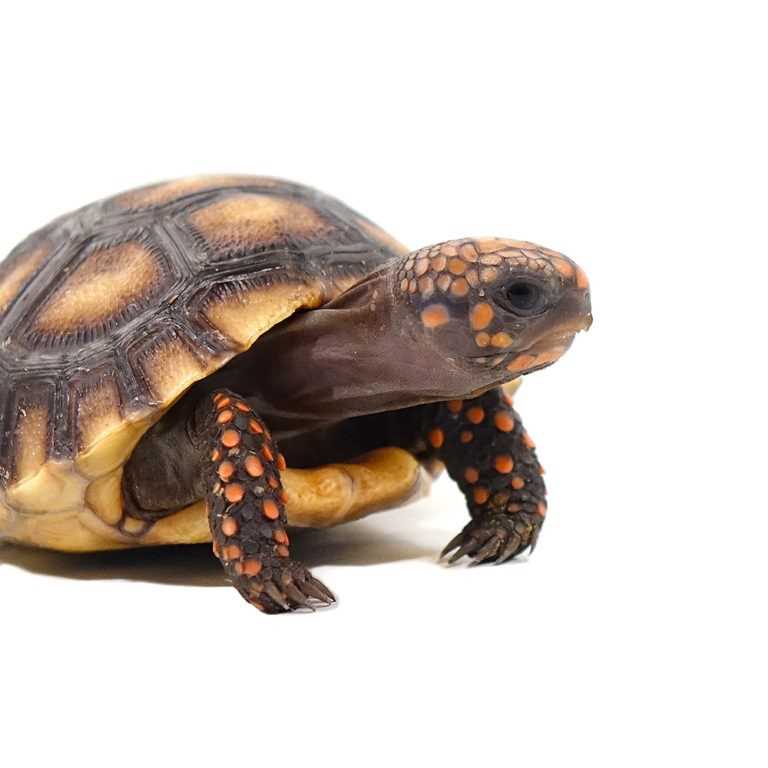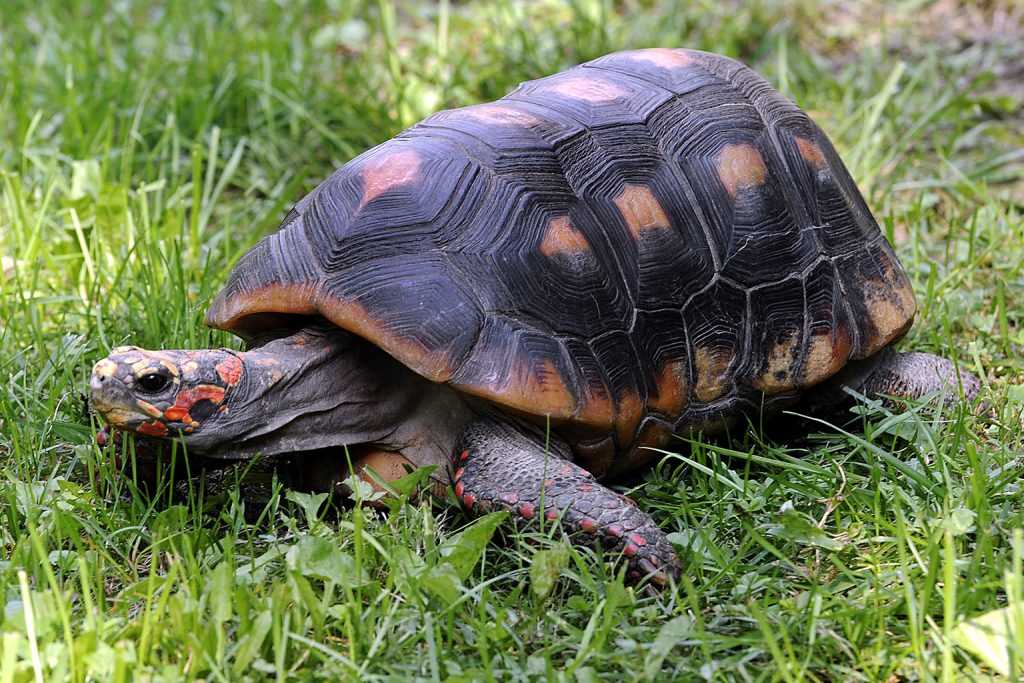One of the most important aspects of caring for a redfoot tortoise is providing them with the right environment. Redfoot tortoises are native to the tropical regions of South America, so they thrive in a warm and humid climate. A terrarium with a temperature range of 75-85 degrees Fahrenheit and humidity levels of 70-80% is ideal for their well-being.
Another crucial element to consider is their shell. The shell of a redfoot tortoise is unique, featuring intricate patterns and deep hues of red and brown. It serves as a protective covering for their delicate body and internal organs. Regular inspection of their shell is essential to ensure it remains in good condition, free from any cracks or infections.
It’s also essential to note that redfoot tortoises are an endangered species. By providing them with proper care, you are not only ensuring their well-being but also contributing to conservation efforts. Remember, when you choose to adopt a redfoot tortoise, you become a responsible guardian of this magnificent creature, playing a vital role in preserving their population and habitat.
Natural Habitat and Distribution of Redfoot Tortoise
In their natural habitat, redfoot tortoises can be found in a variety of environments including tropical rainforests, savannas, and dry forests. They are adapted to living on the forest floor, utilizing fallen leaves and debris for camouflage and protection.
In terms of diet, redfoot tortoises are omnivorous, feeding on a variety of fruits, vegetables, and leafy greens. They also require a source of protein, which can be provided through insects or commercial tortoise diets.
Physical Characteristics of Redfoot Tortoise

One distinct feature of the Redfoot Tortoise is its red scales and spots on its limbs and head, which give it its name. These vibrant colors make it one of the most beautiful tortoises in the world. The shell of the Redfoot Tortoise is typically dark brown or black, with a slightly domed shape.
The average size of a Redfoot Tortoise is around 12-16 inches in length, with some individuals reaching up to 18 inches. They have strong limbs and well-developed claws, perfect for digging and climbing. Their strong jaws allow them to eat a variety of plant matter, making them excellent grazers.
Redfoot Tortoises are also known for their longevity. With proper care, they can live for over 50 years, making them a long-term commitment as a pet. It’s essential to provide them with a spacious enclosure that includes hiding spots, basking areas, and a shallow water dish for soaking.
Choosing the Right Redfoot Tortoise
Species and Subspecies
Size and Age

Health and Appearance
Inspect the redfoot tortoise you are considering for any signs of illness or injury. Look for clear eyes, a smooth and unblemished shell, and active movement. Avoid tortoises with visible shell deformities, respiratory issues, or any other health problems. Choosing a healthy and vibrant redfoot tortoise will contribute to its overall well-being and long-term happiness.
Remember: Keep in mind that redfoot tortoises are protected and classified as an endangered species in some areas. It is crucial to acquire them from reputable breeders or licensed sources in order to avoid supporting illegal wildlife trade.
Temperament and Compatibility
Consider the temperament and compatibility of the redfoot tortoise with other pets or members of your household. While redfoot tortoises are generally docile and easy to handle, they may not thrive in households with aggressive animals or small children who could accidentally injure them. Assess the dynamics of your living environment and ensure that a redfoot tortoise will fit in well.
Setting Up the Perfect Enclosure for Your Redfoot Tortoise
Terrarium
Substrate
Choose a substrate that mimics the forest floor, such as coconut coir or cypress mulch. This will allow the tortoise to burrow and dig, which is a natural behavior. Avoid using substrates that can be ingested and cause digestive issues, such as sand or gravel.
Temperature and Lighting
Redfoot tortoises require a temperature gradient in their enclosure. The ambient temperature should be around 75-85°F (24-29°C), with a basking spot reaching 90-95°F (32-35°C). Use a heat lamp or ceramic heat emitter to provide the necessary warmth. Additionally, provide a UVB light source to help the tortoise synthesize vitamin D3 which is essential for proper calcium absorption.
Humidity
Redfoot tortoises thrive in humid environments, so maintaining a humidity level of 70-80% is important. This can be achieved by misting the enclosure daily and providing a shallow water dish for the tortoise to soak in. It is also recommended to install a hygrometer to monitor the humidity levels closely.
Enrichment
To keep your redfoot tortoise mentally stimulated, provide a variety of hiding spots, climbing structures, and branches for it to explore. This will help mimic its natural habitat and prevent boredom. Adding live plants to the enclosure is also beneficial, as redfoot tortoises are herbivores and enjoy nibbling on vegetation.
Remember, redfoot tortoises are an endangered species, and it is crucial to provide them with proper care and a suitable environment. By following these guidelines and creating the perfect enclosure, you can ensure that your redfoot tortoise remains healthy and happy in its new home.
Diet and Feeding Guidelines for Redfoot Tortoise
Leafy greens should make up a significant portion of the redfoot tortoise’s diet. This can include collard greens, dandelion greens, kale, and mustard greens. These greens are rich in vitamins and minerals that are essential for their overall health.
In addition to leafy greens, the redfoot tortoise can also be offered a variety of fruits and vegetables. Some suitable options include apples, bananas, strawberries, squash, and carrots. These fruits and vegetables can be offered in small pieces or slices, making it easier for the tortoise to consume.
Calcium is also an essential component of a redfoot tortoise’s diet. This can be provided through the incorporation of calcium-rich foods such as cuttlebone or calcium powder sprinkled on their food. This will help ensure proper bone and shell development.
Always make sure to provide fresh, clean water for your tortoise to drink. It is best to use a shallow dish or bowl that they can easily access and drink from.
Healthcare and Common Health Issues of Redfoot Tortoise
Regular visits to a reptile veterinarian are essential to monitor your redfoot tortoise’s health. A vet will perform routine check-ups, fecal examinations, and blood tests to detect any underlying issues. They can also provide guidance on proper diet, habitat, and overall care.
Another health concern is shell problems, such as cracks or pyramiding. Cracks in the shell can occur due to trauma or lack of calcium in the diet. Pyramiding, where the scutes of the shell develop a pyramid-like shape, is often a result of improper nutrition and excessive protein intake. Providing a balanced diet with adequate calcium is crucial to prevent shell issues.
Parasites, such as ticks and mites, can also affect redfoot tortoises. Regularly check your pet for any signs of parasites, such as itching or visible pests. Consult with a veterinarian if you notice any abnormalities.
Redfoot tortoises are herbivores, and their diet plays a significant role in their overall health. Ensure they have access to a variety of fresh vegetables, fruits, and leafy greens. Avoid feeding them foods that are toxic to reptiles, such as avocado or rhubarb.
By providing proper healthcare and addressing any health issues promptly, you can ensure a long and healthy life for your redfoot tortoise.
Interacting and Bonding with Your Redfoot Tortoise
Interacting and bonding with your redfoot tortoise can be a rewarding and enriching experience. Although they may not be as interactive as some other pets, they have their own unique ways of communicating and bonding with their owners.
Creating a Bond
Building a bond with your redfoot tortoise takes time and patience. Remember, they are reptiles and may not show the same affection as a mammal or bird. However, with consistent handling and interaction, they can become more comfortable and familiar with you.
Additionally, providing your redfoot tortoise with a spacious and enriched terrarium can help them feel more secure and comfortable in their environment. Include hiding spots, climbing structures, and areas for basking, as well as a variety of textures and substrates for them to explore. This will allow them to express their natural behaviors and keep them mentally stimulated.
Communication and Body Language
A relaxed tortoise will have a relatively flat shell, and their limbs will be extended. They may also exhibit slow and deliberate movements. Conversely, a stressed or defensive tortoise may retract their head and limbs into their shell, or they may exhibit rapid and jerky movements.
Health and Safety
Regular veterinary check-ups are essential for maintaining your redfoot tortoise’s health. They are generally hardy and resilient animals, but they can still be susceptible to certain health issues.
Monitor their diet and ensure they have access to a balanced and varied nutrition. Redfoot tortoises are herbivores, so their diet should consist of a variety of leafy greens, vegetables, fruits, and some protein sources.
Keep their enclosure clean and maintain appropriate temperature and humidity levels to prevent respiratory issues and shell problems. Additionally, providing a shallow and safe water dish for soaking can help with hydration and skin health.
Conservation and Endangered Status
By owning a redfoot tortoise, you can play a part in their conservation. Educate yourself and others about their natural habitat and the importance of protecting their wild populations.

I’m Lena Adams—a product of an unconventional upbringing in the African wilderness. My father, a daring explorer of African wildlife, sparked my fascination with reptiles, a passion that intertwined with the tragic loss of my mother during an expedition, leaving an indelible mark on my life. Driven to understand the creatures that captivated my parents, I embarked on my journey, sharing insights about reptiles, frogs, and lizards on my website. Through my explorations and conservation efforts, I honour my family’s legacy while seeking connections—to the creatures, nature, and the mother whose presence I yearn to understand.
